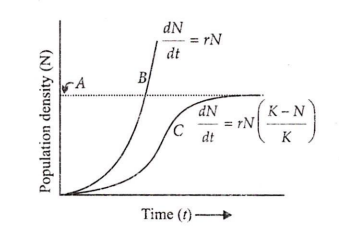 Multiple Choice Questions
Multiple Choice QuestionsChoose the wrong pair
Cenchrus-Savanna
Abies – Coniferous forest
Quercus – Broadleaf forest
Tectona – Temperate forest
Match the following Columns
| Column I (Pollination Technique) | Column II (Pollinator) |
| A. Cheiropterophily | 1. Ant |
| B. Anemophily | 2. Bat |
| C. Myrmecophily | 3. Snail |
| D. Malaciphily | 4. Wind |
A – 3; B – 2; C – 1; D – 4
A – 2; B – 4; C – 1; D – 3
A – 4; B – 3; C – 2; D – 1
A – 1; B – 3; C – 2; D – 4
The permanent decrease in population number occurs due to
migration
natality
emigration
mortality
Study of Ecology of population is called
Autecology
Synecology
Ecotype
Demecology
D.
Demecology
Demecology is a group of individuals of the same species that live in the same area.
Autecology deals with the biological relationship between an individual organism or an individual species and its environment.
Synecology deals with the distribution, abundance and interaction of living organisms at the level of communities, populations and ecosystems.
Ecotype is a distinct form or race of a plant or animal species occupying a particular habitat.
The process where a population inhibits the growth of other population without affecting itself is known as
amensalism
mutualism
parasitism
commensalism
Which of the following is not a factor that would limit the growth of a population
Food shortage
Immigration
Disease
Famine
A small rise in the body temperature of humans is corrected by
(i) sweating
(ii) dilating the skin arteries
(iii) constricting the skin arteries
(iv) increased tension of muscles in the skin
(i) only
(ii) only
(i) and (ii)
(iii) and (iv)
Which of the following associations shows mutualism
Fig and wasp
Barnacles on whale
Roundworms in human intestine
Orchids on mango tree

Which is correctly labelled with respect to the given diagram
B: Logistic curve
C: Carrying capacity
C: Exponential curve
A: Carrying capacity
Assertion: Some marine animals find it difficult to live in fresh water and vice versa.
Reason: Some animals can tolerate a narrow salinity range, while others can tolerate a wide salinity range.
If both assertion and reason are true and reason is the correct explanation of assertion.
If both assertion and reason are true but reason is not the correct explanation of assertion.
If assertion is true but reason is false.
If both assertion and reason are false
